Baseline inbounds
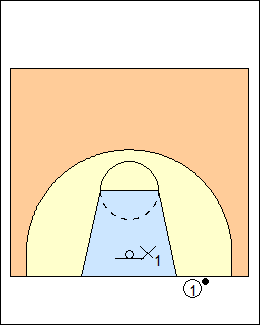 | 1 Tactics to defend baseline inbounds plays in the defensive backcourt. See Defence - Sideline inbounds, Baseline inbounds plays. 1) Del Harris (NBA Coaches Playbook) General coverage of the Dallas Mavericks is man-to-man, and they emphasize taking away two easy looks, the pass under the goal, and a catch and shoot in the ballside corner, where most passes are made. They find zoning up to be riskier against great players, a mistake can permit a quick layup. X1 is the defender on inbounder 1, he moves to an angle off the ball and toward the basket, standing to see both the ball and what's going on behind him, he must have active hands, and can usually prevent an easy pass to the weakside corner. |
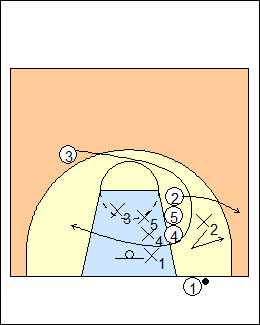 | 2 To prevent an easy ballside corner pass, they might have defenders body up and play their own men, switching only in an emergency (see Jam below), or put a smaller player on the outside of a stack to cover the corner, and another player in the lane area, have them switch (as needed). Here X2 does not go through with cutter 3, passing him off then getting back to cover the corner. Bill Self - defending a baseline out of bounds, the biggest mistake is putting a guy all over the ball, he has to cut off the weakside, and not be up so tight that the inbounder can pass around him. Always piggy-back any screen, don't go ballside. Don't give a cutter a choice, make him go through you to backcut. Don't help so much that a screener gets a layup. |
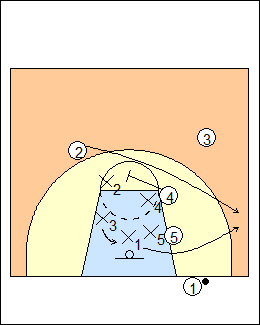 | 3 Some teams have X1 check the middle of the lane then cover the corner while a player in the lane switches to X1's position (here X3, they have to talk). This can be effective if not overdone, but is also risky. |
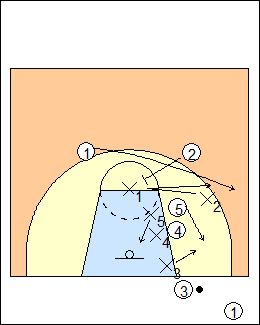 | 4 2) Herb Brown The defender on the inbound passer protects the middle and pressures the ball (shown) or zones up, at times he may be asked to trap or switch on the ball when it is passed to his immediate outside shoulder. Here X1 and X2 come together and switch, X4 bodies up, X5 stops a dive by 4 or 2, if 5 steps out, X3 and X5 can call a switch. |
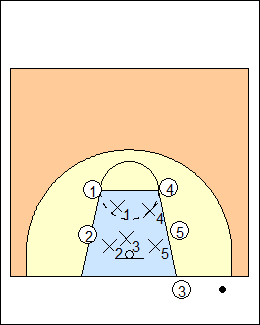 | 5 3) Hoop Tactics a) Jam Defenders sag off and protect the middle before the official hands the ball to the inbounder, X3 guarding the inbounder plays off. |
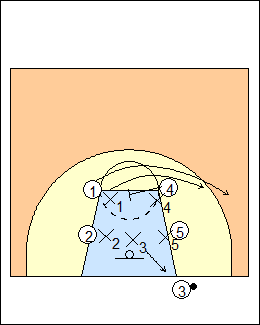 | 6 As 3 gets the ball, X1-X2-X4-X5 step out and aggressively jam their opponents, no switching and no cuts in the lane, disrupt screens by forcing screeners away from the basket, and prevent cutters from using the screens (chest to chest). X3 protects the basket for a three-count then rotates back to the inbounder, both hands up. The inbounds passer is usually a shooter, and will normally go off baseline screens. |
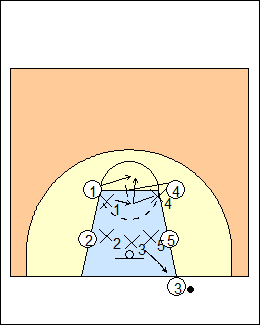 | 7 b) Jump switch Again, sag off and protect the middle, X3 plays off, protects the basket for a three-count when the ball is handed to 3, then rotates back to the inbounder. Other defenders aggressively jump switch any screen, here X4 jumps out into the path of 1, X1 steps over and denies any roll to the basket by screener 4. |
 | 8 c) Trap Sag off and protect the middle, X3 plays off, protects the basket for a three-count when the ball is handed to 3, then rotates back to the inbounder. When 3 makes an inbounds pass, X3 follows and traps the receiver, the other defenders set up a defensive triangle, on a pass out of the trap, players rotate using the nearest-player rule. |
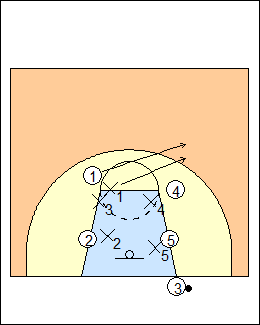 | 9 |
This page was made with Basketball playbook from Jes-Soft
